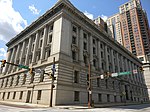Merchants' National Bank Building (1895), Baltimore
Bank buildings on the National Register of Historic Places in MarylandBuildings and structures in BaltimoreDowntown BaltimoreHistoric district contributing properties in MarylandNRHP infobox with nocat ... and 3 more
National Register of Historic Places in BaltimoreOffice buildings completed in 1895Renaissance Revival architecture in Maryland

The Merchants' National Bank Building (1895), Baltimore was a historic bank building at 301 Water Street, at the corner of South Street, in Baltimore, Maryland. It was a 7-story, Renaissance Revival style building designed by the Baltimore-based architectural firm of Baldwin & Pennington, and constructed in 1893-1895. Johns Hopkins, a Baltimore businessman, abolitionist, and philanthropist, had been president of the bank from 1853 until his death in 1873.
Excerpt from the Wikipedia article Merchants' National Bank Building (1895), Baltimore (License: CC BY-SA 3.0, Authors, Images).Merchants' National Bank Building (1895), Baltimore
East Redwood Street, Baltimore Downtown
Geographical coordinates (GPS) Address Nearby Places Show on map
Geographical coordinates (GPS)
| Latitude | Longitude |
|---|---|
| N 39.288611111111 ° | E -76.610555555556 ° |
Address
Business and Government Historic District
East Redwood Street
21203 Baltimore, Downtown
Maryland, United States
Open on Google Maps










